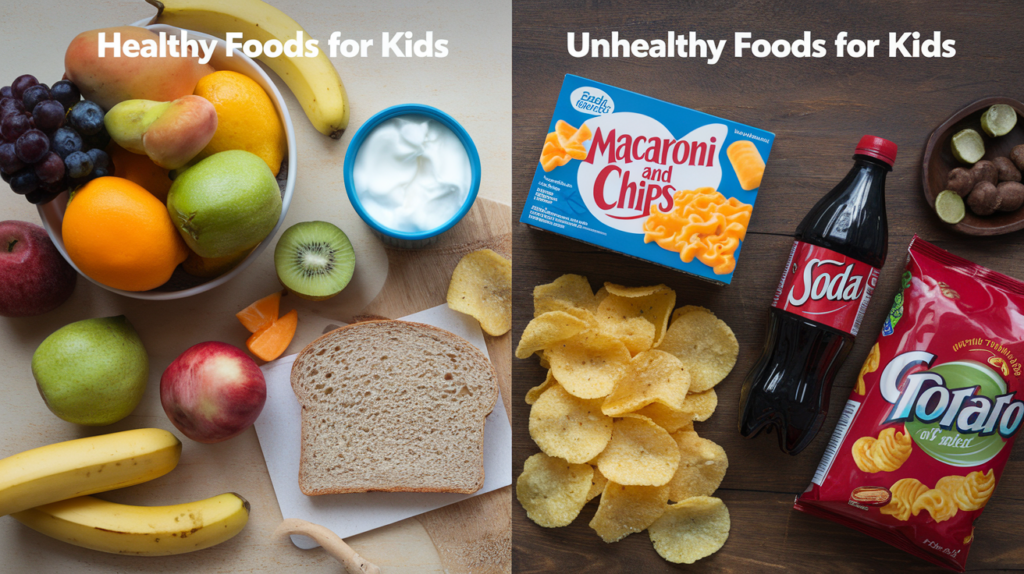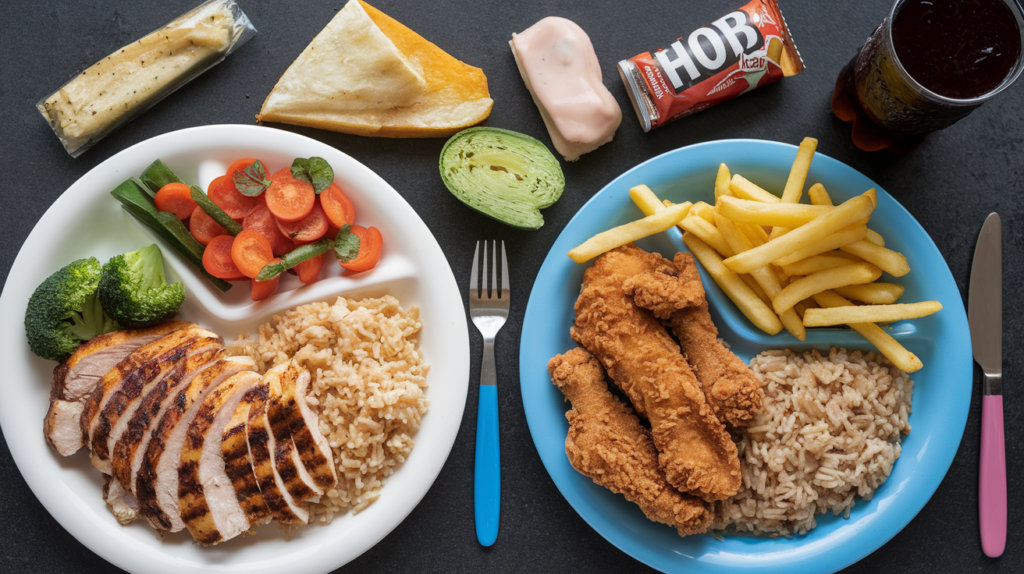From the moment we become parents, one of the primary obligations that we are honored to bear is feeding our kids right. From infancy, food affects a child’s physique and learning abilities, their activity level, attention span, and health in later years. More so due to the availability the fast foods, processed snacks and sugary products make it hard to educate kids on healthy diets. This post is going to discuss the actuality of healthy and unhealthy foods for kids and how to raise their interest in healthy eating.
Good food habits in the children:
Children are not even and need much food because they grow fast. They require vitamins, minerals and other nutrients in their bodies to support this kind of growth. A balanced diet helps children:
- An important aspect about the body for children and other users who The optimally requires bone and muscle mass development.
- Maintain a healthy weight
- Be supportive of cognitive development and concentration.
- Boost their immune system
- Develop nutritionally adequate diets for a long-term successful healthy eating pattern
It is actual when it comes to the quality of the meals kids eat as it determines their short-term health state and long-time health state. If children are not properly fed, they grow up and become obese, develop heart diseases, diabetes and other illnesses as they mature. Therefore, knowledge of the distinction of the foods into the healthy and unhealthy is important to parents.
Healthy Foods for Kids

1. Fruits and Vegetables
Fruits and vegetables are raw foods inclusive of vitamins, minerals, fiber and antioxidants. These foods assist in building the child’s immunity, enhancing digestion process in the body and supplying the body with nutrients such as vitamin C, potassium and folates.
- Examples of healthy fruits: Preserves of apples, oranges, berries, bananas and melons.
- Examples of healthy vegetables: Carrots, spinach, broccoli, cauliflower, cucumbers, sweet potatoes etc.
One strategy that can help make certain that children will take enough of fruits and vegetables is to provide foods that are in different colors and different textures. They also indicated that the more colourful their plate, the better they will be able to capture a wide diversity of nutrients.
Also Read: 10 Harmful Effects of Junk Food
2. Whole Grains
Fiber rich whole grain are extremely beneficial for the stomach and will ensure that the children are full for several hours. Whole grains also contain other nutrients such as B vitamin, iron as well as magnesium.
- Examples of healthy whole grains: Meats like chicken breast, turkey, tuna, and salmon, veggies like carrot, beet, spinach, kale, and broccoli, and whole grain complex carbohydrates like oats, quinoa, brown rice, whole wheat pasta and whole grain bread.
Just replacing refined grains, white bread and pasta for example, with whole grains can have a significant impact on the foods respective nutritional content.
3. Lean Proteins
It is a body builder, it assists in muscle building, tissue repairing and enhancing the immune system in children. It also has a strategic importance in terms of energy production.
- Examples of healthy proteins: Meat products such as chicken, turkey; fishes, eggs; beans, lentils, and tofu.
It is essential to get kids to include different types of proteins in their diets since they all contain the different types of amino acids and other nutrients.
4. Dairy
Milk and other dairy products are also very rich sources of calcium used to build strong bones and teeth. It also contain protein vitamin D and potassium in its composition.
- Examples of healthy dairy options: Skimmed or 1% milk, yogurt and cheese products, fat-free dairy or tetra-packed fortified nut-milk.
For older children it could be advised to take low fat or fat-free dairy products but for the younger kids, it may be recommended to use whole milk for adequate growth of their bones until they are close to 2 years of age.
5. Healthy Fats
Under normal circumstances fats are an essential component of a child’s diet especially in diets for their growing brains. This is where the action should be on healthy fats and not the saturated and the trans fats.
- Examples of healthy fats: Olives, avocados, nuts, seeds, and cold wooden object foods that the French are very familiar with such as olive oil and other kinds of fatty fishes including salmon.
Dietary fats will help with brain health so it is useful to incorporate foods rich in omega-3 fatty acids into your child’s diet.
Unhealthy Foods for Kids

2. Sugary Snacks and Beverages
childhood obesity and poor behaviour is as a result of taking large proportions of sugars. Sugar contains no nutrients or vitamins and causes energy boosts followed by slumps meaning children have difficulty concentrating and wanting to exercise.
- Examples of unhealthy sugary foods: Sweets, chocolates, soft drinks, fruit juices, chocolate bars and sweetened breakfast cereals.
People should avoid the consumption of added sugars but regulation of added sugars does not mean avoiding natural sugars such as those found in fruits.
2. Processed Foods
Canned foods contain more levels of salt, trans and saturated fats, preservatives and little or no vitamins, minerals, fiber and phytochemicals. They can be easy to use, but are often not known for their health benefits.
- Examples of unhealthy processed foods: Snacks, biscuits, noodles, pizzas, and processed foods like fruits and sandwiches.
Such foods tend to contain high levels of sodium and other additives that are likely to have a bad impact on a child’s health.
Must Read: Best Ayurvedic Treatments for Blood Sugar
3. Fried Foods
The foods that are deep fried contain trans and saturated fats which can cause increase in weight, high cholesterol levels and heart disease at old age.
Examples of unhealthy fried foods: Fries, chicken, doughnuts, and onion rings.
Exclusion of fried foods will ensure children do not take a lot of fats and calories that they do not need.
4. Refined Grains
Many foods like white bread, white rice and pasta have been processed in a way that removes most of them nutrients. They can cause fast and sometimes sharp increases in blood sugar levels and are not as satisfying as whole grains products.
Examples of unhealthy refined grains: The processed foods such as white breads, white rice and normal pasta.
Substituting whole grain products is a much healthier way of avoiding fluctuations in energy levels.
5. Saturated and Trans Fats
Healthy fats are included in the list of foods to be encouraged for children while unhealthy fats include foods that are processed, fried foods and foods rich in trans fats are bad for the health in the long-term. Saturated and trans fats are known to lead to heart diseases and obesity.
Examples of foods high in unhealthy fats: Candy bars, potato chips, other salty snacks, most fatty meats, ersatz meats, most breakfast cereals, most processed foods, French fries, onion rings, most frozen foods, most frozen dinners, most dinners and entrees, most junk foods, most chips, crackers, and salty snacks, most cookies and pastries, most mayonnaises and salad dressings, most vegetable oils and margarines.
Those should be restricted especially for people who do not want to get other various ailments in their later years.
Support And Promotion Of Health Eating
He stresses that although advocating for healthy eating in kids is manageable since foods with little nutritional value are extraordinarily packaged with kid-friendly icons and characters. But it is sfot that few good measures can be taken to make parents and their children develop good eating habits around food.
Lead by Example
Young people tend to emulate what they discover in their parents. In a way that you select healthy foods yourself; you are being an inspiration to him/her. If you are putting fruits vegetables and whole grain products on your plates then your child is likely to eat them.
Get Kids Involved
Engage your children in the decision making process with regard to what foods to select and how to prepare them. Let them chop veggies, prepare soup or cereals or even help with cooking or buying food stuff from the supermarket. When kids are involved they are more likely to go for the will meal and eat it since they have had a hand in preparing it.
Make Healthy Food Fun
At other times it is not what you do which counts, but how you do it. Make the foods into shapes keep it interesting or simply use colourful dishes and spoons. A sprinkle of creativity goes a long way; smoothies, fruit kabobs and those neat healthy pizzas will be delightful.
Offer a Variety
Make many healthy foods available, and do not despair if your child refuses something one day. New foods may take between three to fifteen trials before they are accepted by a child, thus do not persist on any one food.
Limit Junk Food
Often, it is good to go for certain treats, but, whenever you possibly can, avoid having the unhealthy stuff and the sugary drinks often. Promote terrible and healthy eating habits by providing finger friendly foods like fruits, nuts and yogurt.
It is hardly a discovery that one of the best things one can to teach children is how to eat healthy foods. Parents can ensure that their children have a bright future by paying attention to what kids eat, consuming many healthy foods while avoiding unhealthy choices. It is, however, important to support the occasional piece of cake with healthy food as the key to your child’s nutrition.

